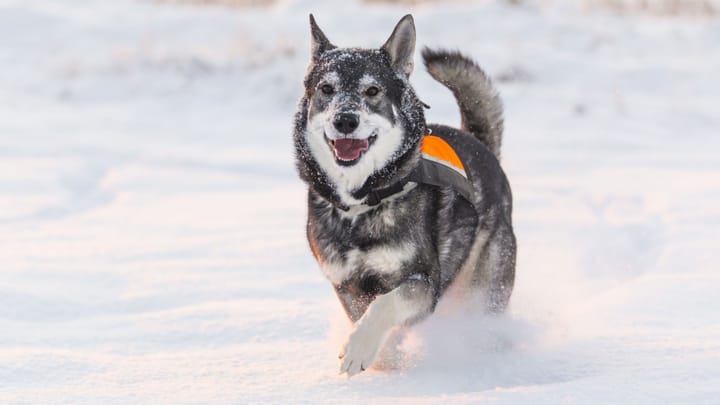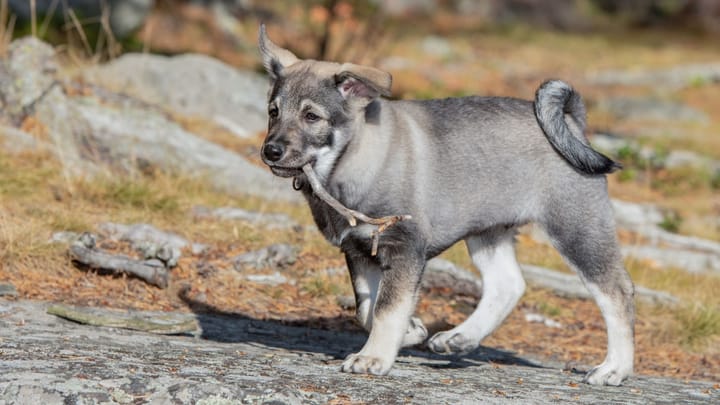Jämthund
Other names : Swedish Elkhound, Swedish Moosehound


The Jamthund is named after a small province in central Sweden. It was developed by mixing domesticated hunting dogs with wild wolves, which explains the breed’s wolf-like appearance. Used as a sled dog, a watchdog, and a hunting companion, the Jamthund is tough, brave, and very loyal. But while they’re very calm and gentle around humans, the Jamthund can become aggressive and dominant towards other dogs. Today, the Jamthund is still used as a hunting dog. They track elk, lynx, and even bears.
|
Life expectancy |
The Jämthund has a life expectancy of between 12 and 14 years |
|
Temperament |
|
|
Size |
Large
|
|
Adult size |
Female
Between 20 and 24 in
Male
Between 22 and 26 in
|
|
Adult weight |
Female
Between 55 and 66 lb
Male
Between 55 and 66 lb
|
|
Coat colour
Grey or dark grey. Black mask, and white markings on muzzle, cheeks, and belly. |
Blue |
|
Type of coat
Harsh, straight topcoat. Soft and dense undercoat. |
Long |
|
Eye colour
Brown. |
Brown
|
|
Purchase price |
The Jämthund costs between £1000 and £1500 |
Often referred to as stubborn, this strong-minded dog needs a confident and competent handler.
Very gentle and soft around the family, but can quickly become aggressive if it perceives any threats to the pack. Early socialisation is crucial.
Shouldn’t be left alone with other pets or small animals.
More details about the Jämthund
Jämthund: Origins and history
Although the Jamthund is a very ancient breed, it wasn’t recognised by a kennel club until 1946. This is because the Jamthund and the smaller Norwegian Elkhound were considered as the same breed. The two dogs have a striking similarity, so it’s understandable how many experts believed that the Jamthund was just a larger version of the Elkhound. It’s named after a central Swedish province called Jamtland and locals refer to this big, powerful breed as the “bear dog.” The Jamthund is one of the few working dog breeds that are brave enough to track and hunt bears. The Jamthund is a social and friendly dog, but many experts recommend against keeping them as just pets. The breed has a natural work ethic and will quickly grow bored of domestic life.
Physical characteristics of the Jämthund
Large spitz breed. Strong, proud stature. Alert expression. A wolf-like appearance.
FCI classification of the Jämthund
-
Group 5 - Spitz and primitive types
-
Section 2 : Nordic Hunting Dogs
Jämthund: Characteristics
Jämthund: Behaviour
Training a Jämthund
Can be a little stubborn. Puppies can struggle to focus during early years training. However, these dogs are willing learners with a desire to please.
Jämthund: Lifestyle
Breed compatibility Jämthund
Jämthund: Purchase price
The initial cost of a Jamthund puppy is between £1,000 to £1,500. The average cost to keep one of these dogs (including vet bills, insurance, and food) is between £50 to £100 a month.
Jämthund: Grooming
A weekly brush. Without this, their coats can become matted and tangled. This is very uncomfortable and can also lead to skin infections and other health complications.
Jämthund: Health
A very healthy and well-bred dog. Their average life expectancy is between 12 and 14 years.
These dogs have been hunting some of the world’s largest and most dangerous predators for thousands of years. Bred to survive in the harshest natural environments. Very strong. Very robust.
Sheds during the spring, which helps keep them cool in summer. However, they’re not designed for warmer climates. Will feel uncomfortable in hotter countries.
They have a thick, double-layered coat that provides protection against the cold, the rain, and the wind. No problems surviving the cold.
No issues with weight or obesity. Any unexplained weight gain could be linked to an underlying health issue. Consult a vet for more advice.
- Hip dysplasia
- Elbow dysplasia
- Glaucoma
- Skin allergies
- Progressive Retinal Atrophy







